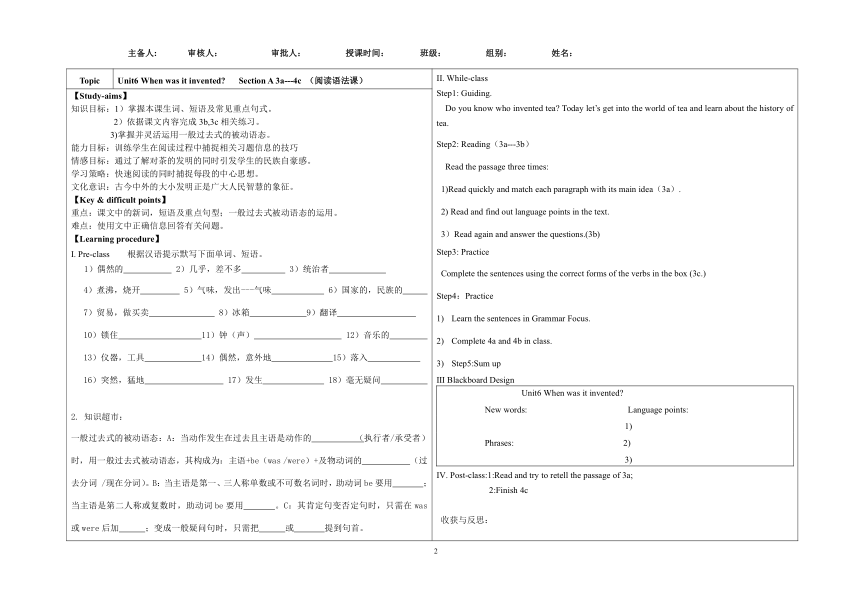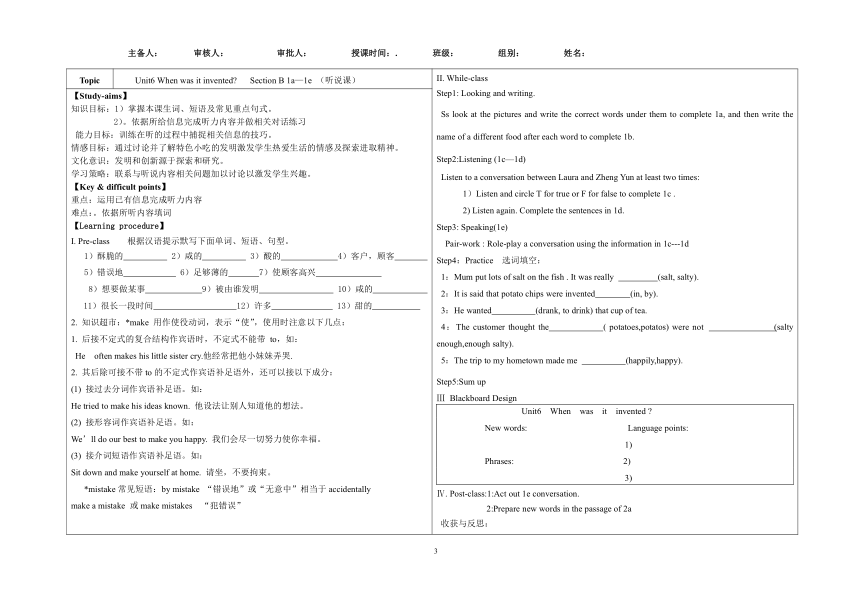Unit 6 When was it invented教案
文档属性
| 名称 | Unit 6 When was it invented教案 |  | |
| 格式 | zip | ||
| 文件大小 | 27.6KB | ||
| 资源类型 | 教案 | ||
| 版本资源 | 人教新目标(Go for it)版 | ||
| 科目 | 英语 | ||
| 更新时间 | 2020-05-14 20:54:11 | ||
图片预览



文档简介
主备人: 审核人: 审批人: 授课时间: 班级: 组别: 姓名:
Topic Unit6 When was it invented? Section A 1a—2d (听说课) ⑵ 1b.listen and match the inventions with the years. ⑶ 1c.practice the conversations between A and B.3. 当堂检测:⑴根据句意写单词 The bus mustn’t carry too many .② That’s a good idea. I with you. (4)2a.listen and number the inventions [1—3]in the order you hear them (5)2b.listen again and complete the chart below. (6)2d.Role play the conversation, according to the knowledge point’s .Then answers the questions. 1. What does the conversation talk about?2. Who invented it?3. When was it invented?(7) 小结:Ⅲ. Post-class 1能了解部分有用的发明。 2熟练运用2d中的句式. 3.完成巩固练习。4 收获与反思: 【Blackboard Design】Unit6 When was it invented? Section A 1a—2d 1. What does the conversation talk about?2. Who invented it?3. When was it invented?
【Study-aims】知识目标: 掌握本课的新单词,短语及常见重点句式。 掌握一般过去时的被动语态的基本构成。 能力目标: 学会运用被动语态谈论发明物的历史,描述物品的用途。情感目标: 通过学习了解人类历史上的部分重要发明,培养爱科学,学科学的思想学习策略: 通过练习对话去掌握重要语言点。文化意识:让学生更多的了解科技带给我们的便利。【Key & difficult points】 介绍某项发明及其优点用途的句式 。【Learning procedure】I. Pre-class 1. 写出以下发明物的英文名称 有特殊跟的鞋 有电灯的鞋 靠电能运行的热冰激凌勺 拉链 2. 知识超市: ⑴ with 带有,具有 with +名词修饰其前的名词,常作定语,此结构可与定语从句who/that has...替换。 ⑵ My pleasure! 我很荣幸 !常用作别人请你帮忙时你的客气回答 。 pleasure n.高兴;愉快 ⑶ You do seem to have a point .看起来你确实说得有道理。 此交际用语用来赞同别人的观点。⑷ list v.列表,列清单。 n.名单;清单 动词时是及物动词,名词时是可数名词 。 II. While-class 1. 导入新课 Today, let’s learn special inventions that changed our world. 2. Learning the new knowledge:⑴ 1a.look at the things below and finish it.
主备人: 审核人: 审批人: 授课时间: 班级: 组别: 姓名:
Topic Unit6 When was it invented? Section A 3a---4c (阅读语法课) II. While-class Step1: Guiding. Do you know who invented tea? Today let’s get into the world of tea and learn about the history of tea.Step2: Reading(3a---3b) Read the passage three times: 1)Read quickly and match each paragraph with its main idea(3a). 2) Read and find out language points in the text. 3)Read again and answer the questions.(3b) Step3: Practice Complete the sentences using the correct forms of the verbs in the box (3c.)Step4:Practice Learn the sentences in Grammar Focus. Complete 4a and 4b in class.Step5:Sum upⅢ Blackboard Design Unit6 When was it invented? New words: Language points: 1) Phrases: 2) 3) Ⅳ. Post-class:1:Read and try to retell the passage of 3a; 2:Finish 4c 收获与反思:
【Study-aims】知识目标:1)掌握本课生词、短语及常见重点句式。 2)依据课文内容完成3b,3c相关练习。 3)掌握并灵活运用一般过去式的被动语态。 能力目标:训练学生在阅读过程中捕捉相关习题信息的技巧 情感目标:通过了解对茶的发明的同时引发学生的民族自豪感。 学习策略:快速阅读的同时捕捉每段的中心思想。 文化意识:古今中外的大小发明正是广大人民智慧的象征。【Key & difficult points】重点:课文中的新词,短语及重点句型;一般过去式被动语态的运用。难点:使用文中正确信息回答有关问题。 【Learning procedure】I. Pre-class 根据汉语提示默写下面单词、短语。1)偶然的 2)几乎,差不多 3)统治者 4)煮沸,烧开 5)气味,发出---气味 6)国家的,民族的 7)贸易,做买卖 8)冰箱 9)翻译 10)锁住 11)钟(声) 12)音乐的 13)仪器,工具 14)偶然,意外地 15)落入 16)突然,猛地 17)发生 18)毫无疑问 2. 知识超市:一般过去式的被动语态:A:当动作发生在过去且主语是动作的 (执行者/承受者)时,用一般过去式被动语态,其构成为:主语+be(was /were)+及物动词的 (过去分词 /现在分词)。B:当主语是第一、三人称单数或不可数名词时,助动词be要用 ;当主语是第二人称或复数时,助动词be要用 。C:其肯定句变否定句时,只需在was或were后加 ;变成一般疑问句时,只需把 或 提到句首。
主备人: 审核人: 审批人: 授课时间:. 班级: 组别: 姓名:
Topic Unit6 When was it invented? Section B 1a—1e (听说课) II. While-classStep1: Looking and writing. Ss look at the pictures and write the correct words under them to complete 1a, and then write the name of a different food after each word to complete 1b. Step2:Listening (1c—1d)Listen to a conversation between Laura and Zheng Yun at least two times: 1)Listen and circle T for true or F for false to complete 1c . 2) Listen again. Complete the sentences in 1d.Step3: Speaking(1e) Pair-work : Role-play a conversation using the information in 1c---1dStep4:Practice 选词填空: 1:Mum put lots of salt on the fish . It was really (salt, salty). 2:It is said that potato chips were invented (in, by). 3:He wanted (drank, to drink) that cup of tea. 4:The customer thought the ( potatoes,potatos) were not (salty enough,enough salty). 5:The trip to my hometown made me (happily,happy).Step5:Sum upⅢ Blackboard Design Unit6 When was it invented ? New words: Language points: 1) Phrases: 2) 3) Ⅳ. Post-class:1:Act out 1e conversation. 2:Prepare new words in the passage of 2a收获与反思:
【Study-aims】知识目标:1)掌握本课生词、短语及常见重点句式。 2)。依据所给信息完成听力内容并做相关对话练习 能力目标:训练在听的过程中捕捉相关信息的技巧。情感目标:通过讨论并了解特色小吃的发明激发学生热爱生活的情感及探索进取精神。文化意识:发明和创新源于探索和研究。学习策略:联系与听说内容相关问题加以讨论以激发学生兴趣。【Key & difficult points】重点:运用已有信息完成听力内容难点:。依据所听内容填词【Learning procedure】I. Pre-class 根据汉语提示默写下面单词、短语、句型。1)酥脆的 2)咸的 3)酸的 4)客户,顾客 5)错误地 6)足够薄的 7)使顾客高兴 8)想要做某事 9)被由谁发明 10)咸的 11)很长一段时间 12)许多 13)甜的 2. 知识超市:*make 用作使役动词,表示“使”,使用时注意以下几点: 1. 后接不定式的复合结构作宾语时,不定式不能带 to,如: He often makes his little sister cry.他经常把他小妹妹弄哭. 2. 其后除可接不带to的不定式作宾语补足语外,还可以接以下成分: (1) 接过去分词作宾语补足语。如: He tried to make his ideas known. 他设法让别人知道他的想法。 (2) 接形容词作宾语补足语。如: We’ll do our best to make you happy. 我们会尽一切努力使你幸福。 (3) 接介词短语作宾语补足语。如: Sit down and make yourself at home. 请坐,不要拘束。 *mistake常见短语:by mistake “错误地”或“无意中”相当于accidentally make a mistake 或make mistakes “犯错误”
主备人: 审核人: 审批人: 授课时间: 班级: 组别: 姓名:
Topic Unit 6 When was it invented?Section B 2a—2e(阅读课) 你对篮球这种运动知道多少?请各小组讨论一下,然后分享各自的想法。 3、三读课文:(1)快速阅读课文,找出每段的中心意识。(2)慢读课文,用短文的信息完成思维导图。你还能在思维导图上加些什么吗? Game played inside on a hard ______ / ______ teams get _______ into other team’s ______ Development invented by _______ / first game on ________ became Olympic event in _______ in the year ________ most famous games : ________ / popular games in China : _______ Popularity played by _______ people / over _______ countries(3)再读课文,用思维导图总结的信息回答下列问题。 1)Who invented basketball and how is it played ? 2) When was the first basketball game in history played? 3) Why were the Berlin Olympics important for basketball? 4) What are the professional basketball groups in America and China? 5) How popular is basketball? 4、理解课文教师画出重点短语和句式,学生以小组为单位翻译并讲解。然后学生展示,教师点拨。读后总结你如何看待著名的篮球运动员?列一份关于作为一名著名的篮球运动员的好的事情和困难的时期的清单。 Good things: Difficult things:6 板书设计:Unit 6 When was it invented? Section B 2a---2e stop sb./sth. From doing sth. dream of/about (doing)sth.not only…but also…III. Post-class背诵划线短语和知识点,复述课文。
【Study-aims】知识目标:1、掌握本节课新单词和短语。 Canadian divide basket popularity hero professional the Olympics divide…into… not only…but also… look up to 2、掌握一般过去式的被动语态。能力目标:能用一般过去式的被动语态谈论物体的发明。情感目标:热爱神奇的大自然,热爱伟大的人类发明;珍惜现在的生活,不虚度光阴。 学习策略:把读到的信息转变成思维导图。文化意识:并了解篮球这一运动的起源和发展。【Key & difficult points】一般过去式的被动语态。【Learning procedure】I. Pre-class(一)重点单词Canadian ___________(国家名) 2、divide __________(过去式)3、purpose ____________(同义词) 4、hero __________(复数)(二)重点短语 1、错误地 ______________ 2、最后 _______________ 3、历史上 _____________ 4、 同时 _______________ 5、崇拜 _______________ 6、决定 ________________ 7、把……分成…… _______________ 8、不仅……而且……_______________(三)重点句型 1、你知道篮球是什么时候被发明的吗? 谁发明了篮球? 历史上第一次篮球比赛是什么时候? 为什么柏林奥运会对篮球运动来说很重要?II. While-class1、导言: Dou you like basketball? Do you watch basketball games? How much do you know about the sport? In this lesson we are going to talk about it. 2、读前热身活动:
主备人: 审核人: 审批人: 授课时间: 班级: 组别: 姓名:
Topic Unit 6 When was it invented?Section B 3a—Self Check (写作复习课) 的基本结构为“______________________”。 II. While-class1、导言: We have learned a lot of inwentions,they are useful and helpful. Then do you want to have your own invention? 2、写前热身活动:想出你不喜欢的某件事。然后想出一项能帮助你的发明。记笔记。 Problems: New invention: What it is used for: 3、写作:假如你是一名商人,写一份关于你的新发明的描述。写作指导本单元我们主要学习了被动语态,要学会运用被动语态谈论发明的历史,描述物体的用途。此类文体属于说明文,说明文常用一般现在时。写此类文章应明确说明的先后顺序,描述产品的特点及用途,然后结合发明给人们带来的便利谈谈自己的感受。(二)写作模板点明主题: My problem is … So I think … is one of the most useful inventions.介绍产品的特点及用途: be used for … / can help … (to) do …对产品的评价:useful / helpful / have changed our life and …(三)写作练习 ________________________________________________________________________________________________________________________________________________________________________________________________________________________________________________________________________________________________________________________________ 4、复习总结 小组合作探究,共同总结本单元知识,并完成Self Check 1-3.5、板书设计: Unit 6 When was it invented? Section B 3a---Self Check I think … is one of the most useful inventions. be used for … / can help … (to) do … useful / helpful / have changed our life and … III. Post-class:背诵本单元重点单词、短语和句型。
【Study-aims】知识目标: 复习本单元重点单词、短语和句型。能力目标:能用一般过去式的被动语态描述一份新发明。情感目标:热爱神奇的大自然,热爱伟大的人类发明。 学习策略:小组合作探究,总结本单元相关知识。文化意识:了解人类发展过程中一些重大发明。【Key & difficult points】一般过去式的被动语态。【Learning procedure】I. Pre-class(一)重点单词1、style _________ 2、_______项目;工程 3、pleasure _________ 4、_________提到;说到 5、nearly ____________ 6、ruler ____________ 7、remain __________ 8、smell _________ 9、_________国家的;民族的 10、doubt _________ 11、_________低的;矮的 12、_________某人;重要任务 13、___________翻译 14、lock __________ 15、sudden __________ 16、sour __________ 17、____________顾客;客户 18、Canadian _________ 19、________分开;分散 20、hero________ 21、pioneer___________(二)重点短语 1、______________ 偶然;意外地 2、 _______________发生;出现 3、without doubt _____________ 4、_______________突然;猛地 5、by mistake_______________ 6、divide…into ________________ 7、_______________钦佩;仰慕 8、have a point_______________ 9、_______________鼓励某人做某事 10、_______________不但……而且……(三)重点句型 1、—拉链是什么时候发明的? —它是1893年发明的。 —___________ ____________the zipper invented? —It ____________ ___________in 1893. 2、—茶是什么时候被带到韩国的? —它是在6、7世纪期间被带到韩国的。 —When ________ tea _________ _________Korea? —It ________ _________ ________Korea during the 6th and 7th centuries.(四)语法一般过去时的被动语态的肯定句的基本结构为“_____________”; 否定句的基本结构为“_________________”; 一般疑问句的基本结构为“__________________”; 特殊疑问句
PAGE
3
同课章节目录
- Unit 1 How can we become good learners.
- Section A
- Section B
- Unit 2 I think that mooncakes are delicious!
- Section A
- Section B
- Unit 3 Could you please tell me where the restroom
- Section A
- Section B
- Unit 4 I used to be afraid of the dark.
- Section A
- Section B
- Unit 5 What are the shirts made of?
- Section A
- Section B
- Review of Units 1-5
- Unit 6 When was it invented?
- Section A
- Section B
- Unit 7 Teenagers should be allowed to choose their
- Section A
- Section B
- Unit 8 It must belong to Carla.
- Section A
- Section B
- Unit 9 I like music that I can dance to.
- Section A
- Section B
- Unit 10 You're supposed to shake hands.
- Section A
- Section B
- Review of Units 6-10
- Unit 11 Sad movies make me cry.
- Section A
- Section B
- Unit 12 Life is full of the unexpected
- Section A
- Section B
- Unit 13 We're trying to save the earth!
- Section A
- Section B
- Unit 14 I remember meeting all of you in Grade 7.
- Section A
- Section B
- Review of Units 11-14
